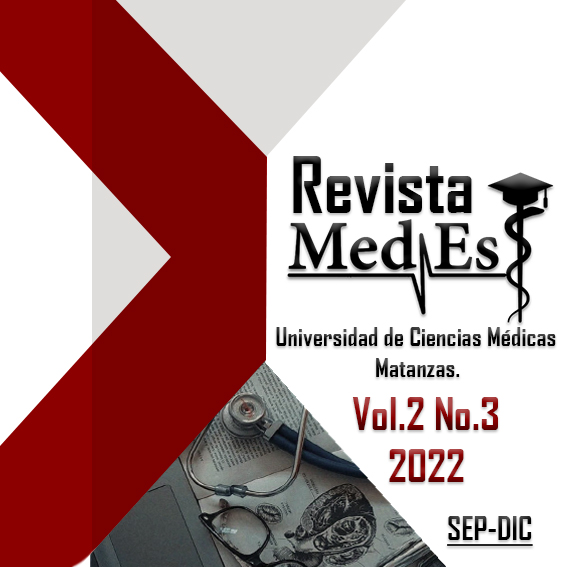Treatment plan in a patient with periodontitis, presentation of a case
Keywords:
Periodontal disease, Periodontitis, TreatmentAbstract
Periodontal treatment planning should be based on the clinical data gathered from the patient's examination, diagnosis, and prognosis of each of the teeth. Due to the frequency with which patients with periodontitis seeking periodontal treatment appear in the dental office, this article was discovered, which aims to characterize the treatment plan of a patient with adult periodontitis. The case of a 53-year-old male patient was presented, who attended the Periodontics consultation, referred from basic services because after being evaluated and treated, bleeding persists when brushing the gums, periodontal pockets of 3 to 7 mm and tooth mobility. After anamnesis, clinical and radiographic examination, localized adult periodontitis was diagnosed from 17 to 18, 35 to 38, 42 to 43, 45 to 48 with an overall favorable prognosis. The initial treatment was continued with promotional activities, tartarectomy, drug therapy, and in its surgical corrective stage with scaling and root planing and a mucoperiosteal flap filled with biomaterial. The treatment plan of the periodontal patient must be sequential and evolutionary in order to resolve the patient's reason for consultation. Procedures aimed at eliminating the causes, symptoms and signs of the disease should be arranged in advance to restore the patient's periodontal health.Downloads
References
2. Peña Sisto M, Santos Toledo L. Cambios clínicos y radiográficos en pacientes con periodontitis tratados con plasma rico en plaquetas. MEDISAN [Internet]. 2017 [citado 2022 Feb 21]; 21(4): 465-469. Disponible en: http://scielo.sld.cu/scielo.php?script=sci_arttext&pid=S1029-30192017000400012&lng=es
3. Collazo Zulueta MA. Retos de la medicina regenerativa (lisado de plaquetas) en el tratamiento de la periodontitis crónica del adulto. Rev.Med.Electrón. [Internet]. 2020 [citado 2022 Feb 21]; 42(2): 1732-1734. Disponible en: http://scielo.sld.cu/scielo.php?script=sci_arttext&pid=S1684-18242020000201732&lng=es.
4. Kwon TH ; Lamster IB, Levin L .Current Concepts in the Management of Periodontitis.Abolladura interna J [Internet]. 2020 [citado 2022 Feb 21]; 71(6): 462-476.Disponible en: https://doi.org/10.1111/idj.12630
5. Peña M, Vaamonde C, Vilarrasa J, Vallés C, Pascual A, Shapira L, Nart J. Diagnóstico y tratamiento de las enfermedades periodontales: De lo imposible a lo posible. Periodoncia Clínica. [Internet]. 2018 [citado 2022 Feb 26] 1: 11-19. Disponible en: http://www.sepa.es/web_update/wp-con-tent/uploads/2018/09/Revista-Periodoncia-Cli%CC%81nica-N%C2%BA-11-Definitivo.pdf
6. Millán Isea RE, Salinas Millán YJ, Maestre LP, Paz de Gudiño M. Enfermedad periodontal y tratamiento ortodóncico: Reporte de un caso clínico. Acta odontol. venez [Internet]. 2007 [citado 2022 Feb 28]; 45(2): 280-282. Disponible en: http://ve.scielo.org/scielo.php?script=sci_arttext&pid=S0001-63652007000200030&lng=es
7. Moreno Caicedo L, Amaya Sánchez S, Cruz Olivo E. Factores de riesgo modificables e inmodificables de la periodontitis: revisión narrativa. Univ Odontol [Internet]. 2018 [citado 25 Nov 2022]; 37(79). [aprox. 26 p.]. Disponible en: file:///C:/Users/Aida/AppData/Local/Temp/jdelgado,+UO2018v37n79_06_Moreno_etal.pdf
8. Díaz Sánchez LS, Jiménez Castellanos MI, Páez Delgado D, Díaz Sánchez LH. Enfermedades bucales y factores de riesgo en la población geriátrica perteneciente a un consultorio médico. MEDISAN [Internet]. 2018 [citado 2022 Feb 21]; 22(5): 483-9. Disponible en: http://scielo.sld.cu/scielo.php?script=sci_arttext&pid=S1029-30192018000500005&lng=es.
9. Fonseca Vázquez M, Ortiz Sánchez Y, Martínez Sánchez N, Rosales Ortiz A, Proenza Pérez D. Factores de riesgo asociados a la periodontitis crónica en pacientes adultos. Multimed [Internet]. 2021 [citado 2022 Feb 21]; (25)6: e2251. Disponible en: http://scielo.sld.cu/scielo.php?script=sci_arttext&pid=S1028-48182021000600003&lng=es.
10. Morón Araújo M. El Estrés y Bruxismo por COVID-19 como Factores de Riesgo en la Enfermedad Periodontal. Int. J. Odontostomat [Internet]. 2021 [citado 2022 Feb 28]; 15(2): 309-314. Disponible en: http://www.scielo.cl/scielo.php?script=sci_arttext&pid=S0718-381X2021000200309&lng=es.
11. Pérez Barrero B, Ortiz Moncada C, Duharte Garbey C, Sánchez Zapata R. Severidad de la periodontitis crónica en el adulto mayor. Medimay [Internet]. 2020 [citado 28 Feb 2022]; 27 (2): [aprox. 9 p.]. Disponible en: http://revcmhabana.sld.cu/index.php/rcmh/article/view/1646
12. Rendón Osorio WL, Guzmán Zuluaga IC, Torres Quiroz IX, Botero Zuluaga L. Tratamiento clínico de un paciente con periodontitis crónica avanzada generalizada en la Facultad de Odontología de la Universidad de Antoquia, Medellín, Colombia: reporte de un caso. Revista Facultad de Odontología Universidad de Antoquia [Internet]. 2012 [citado 2022 Feb 26]; 24(1). Disponible en: http://www.scielo.cl/scielo.php?script=sci_arttext&pid=S0121-246x2012000200012
13. Bohner M, Santoni BLG, Döbelin N. β - tricalcium phosphate for bone substitution: Synthesis and propierties. Acta biomateriala. [Internet]. 2020 [citado 2022 Feb 28]; 113(1). Disponible en: https://doi.org/10.1016/j.actbio.2020.06.022
14. Jasser RA, AlSubaie A, AlShehri F. Effectiveness of beta-tricalcium phosphate in comparison with other materials in treating periodontal infra-bony defects around natural teeth: a systematic review and meta-analysis. BMC oral health [Internet]. 2021 [citado 2022 Feb 28]; 21(1). Disponible en: https://doi.org/10.1186/s12903-021-01570-8
15. Kishore DT, Bandiwadekar T, Padma R, Debunath S, Profulla, Reddy A. Evaluation of relative efficacy of β-tricalcium phosphate with and without type I resorbable collagen membrane in periodontal infrabony defects: a clinical and radiographic study. The journal of contemporary dental practice [Internet]. 2013 [citado 2022 Feb 28]; 14(2). Disponible en: https://doi.org/10.5005/jp-journals-10024-1299
Downloads
Published
How to Cite
Issue
Section
License
Those authors who have publications with this journal accept the following terms: The authors will retain their copyright and guarantee the journal the right of first publication of their work, which will be simultaneously subject to the Recognition License. Creative Commons that allows third parties to share the work as long as its author and its first publication in this magazine are indicated. Authors may adopt other non-exclusive license agreements for the distribution of the published version of the work (e.g.: deposit it in an institutional telematic archive or publish it in a monographic volume) as long as the initial publication in this journal is indicated. Authors are allowed and recommended to disseminate their work through the Internet (e.g.: in institutional telematic archives or on your website) before and during the submission process, which can produce interesting exchanges and increase citations of the published work.





